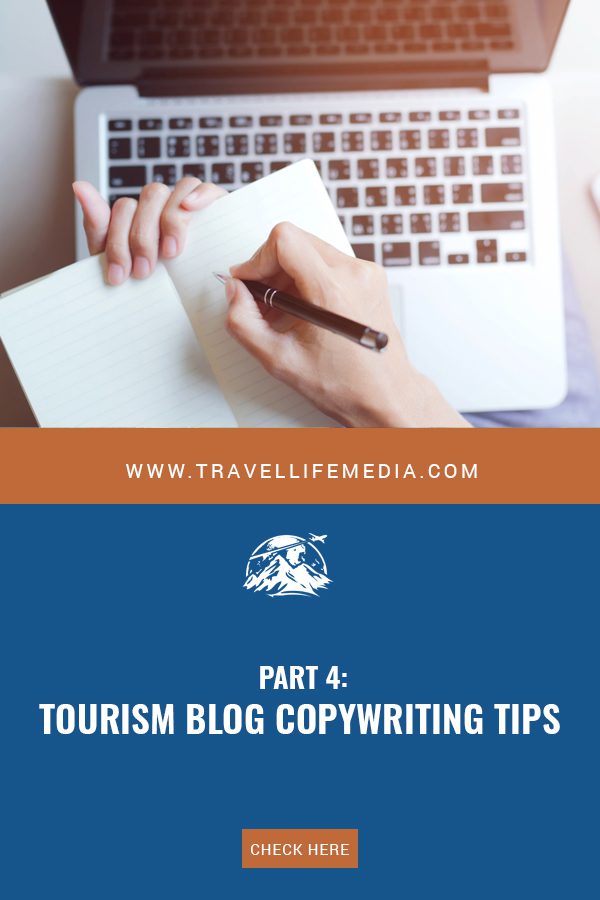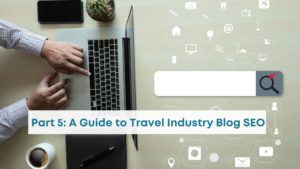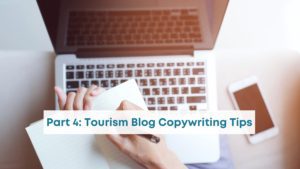Welcome to Part 4 of this blogging series for tourism brands. You can listen to the podcast series featured here or read the podcast’s key points and top tips below. In this post, get ready to blog as I share the most helpful and effective blog copywriting tips for tourism brands. If you missed Part 3 of this series; how to reuse content, you can find it here.
Whether it is your first time writing a blog post or on your 5th one, writing is hard work. Fortunately, you can do something to make the blog copywriting process easier. Let’s save some time and energy and get rid of overwhelm with writing.
Getting Started with Tourism Blog Copywriting
With a list of blog post ideas, writing becomes easier. But how do you start writing once you have chosen a tourism topic?
1. Develop an outline.
An outline is the foundation of your blog. It consists of the general idea and essential details of what you will write. Creating an outline is important as it will save you a huge amount of time. Imagine going on an adventure with a map—your journey will be easier and quicker with it. That’s what a blog outline does!
“How do I create a blog outline?” Here’s a simple guide to help you.
2. Start with a quick brainstorming.
All you have to do is write down key headlines and main ideas you want to include in your blog post. You can list them down in bullets. Once the general ideas are laid out, separate them into main or secondary points. Some points can be used to describe or support the main idea; others may become the headings or subheadings. At this point, do not worry about grammar.
3. Do keyword research.
Now is the best time to do in-depth research of the best keywords to incorporate into your blog. Keywords are a basic yet essential part of blog copywriting. They help you identify the kind of search queries users use to find answers. Keywords should be weaved naturally into your writing. As you create an outline, you can also plan your keyword strategy and organize them to avoid forcing them in the blog post.
4. Identify the links you want to include in your blog post.
If there are links you want to include in your post, you can jot them down in your outline. These links may be internal—links that direct to your other pages, or external links, which are links that point readers to a page on a different website. Whether internal or external link, make sure that each link will add value to your blog by supplementing helpful information.
Plan where you will add the links by mapping them out in your outline in sections where they are most relevant to the content. Links are important to both SEO and your readers. Adding links is also a way to give credit to the owner of any facts or stats you shared on your blog and shows your professionalism.
Ideally, each blog post should contain:
- Three relevant internal links
- Three relevant external links from high-authority websites with higher domain authority than yours
- No random links
5. Write from Your Audience’s POV.
Understanding what point of view (POV) to use when writing helps establish the consistency of your brand. Regardless of industry, it is ideal to write from the point of view of your readers. Imagine you are talking to a friend and recommending a tourism destination you know they will love. Naturally, you will use the second person POV or the “You POV” and use ‘you’ and ‘yours.’
Readers always consider the information they will get if they read a blog post. Consistently using the” You perspective” helps pull them into your writing and thinking by putting them into your story. It also expresses closeness or intimacy between you and the reader, making the experience less detached.
6. The Rule of One.
Another rule to keep in mind is the rule of one. When writing, always write with one reader in mind. Sure, your audience is diverse, and not everyone has the same interests, needs, preferences, backgrounds, etc. But writing for a certain type of people will make your blog copywriting more effective.
For example: 20 Best Trips for Solo Single Female Travel
The blog post above targets a specific group of solo single female travelers. It focuses on the needs of one reader, allowing you to use very specific words or phrases to tap on their emotions and encourage them to continue reading.
The Essentials of Blog Copywriting for Every Post
1. Blog Title
Titles are the first part of your blog post that potential readers will see. A title has one job: to grab someone’s attention and convince them to read. The sad part is 60% of readers do not read beyond the title. So, what should you do to make sure your audience opens your blog post and read it?
The most effective titles are short but impactful. Aim for a title with no more than 50 characters, so it fits on the search engine results page without getting cut off. Also, consider your business name that will appear after the blog title. According to HubSpot, the most shareable blog titles consist of an average of 8 to 12 words.
There are online tools that analyze your blog post title and determine whether it has a good probability to grab attention or not. Coschedule has a great headline analyzer tool that can help you decide on a title. You can try it out and learn about the factors that determine a good headline.
Another helpful resource is a course by Marie Foleo called The Copy Cure. This course includes many good tips on developing headlines and writing in general. I have also shared more blog copywriting tips for the tourism industry, which will be useful as you write tourism blog posts.
2. Introduction
An introductory paragraph is necessary to provide your readers with the gist of the article and entice them to read on. You can ask a question or use a hook, humor, or an interesting or surprising fact. Ask yourself: “What are the things that convince me to continue reading?” The more you do, the better you will get at creating introductions and writing blog posts in general.
3. Body of the Post
When writing blogs, the rule of thumb is to have every paragraph contain a maximum of only four sentences. This way, bigger chunks of text are broken down into smaller parts, allowing the readers to follow your writing easier. It also helps them consume your content and quickly find the answers they are looking for.
Make sure to add headings and subheadings, when necessary. Headings help break down your content for easy readability. Use pictures that are relevant to your blog post. Pictures are a great way to add life to your writing and help keep the interest of your readers.
4. Call to Action
When creating an outline, think about the path you want your readers to take. Anything that prompts the readers to take action (to respond), is your call to action.
Do you want them to contact you for more information? Provide a link to your contact page.
Do you want them to read a whole series of blog posts? Direct them to your blog page or a certain blog post.
Do you want them to book a tour? Give the link to your booking page.
5. The Blog Sweep
This is the final stage of writing your piece. Here are some key tips to ensure your blog post is ready to upload.
- Read it out loud. You will inevitably find some things that are not relevant, do not make sense, or do not flow naturally.
- Use Grammarly to improve the quality of your writing. It is a great tool to enhance your grammar and word choice.
- Check if keywords have been added naturally.
- Ensure you have provided answers to the questions of your audience. After all, most blogs are written to help readers find information and learn something new, right
Summary
Creating an outline, understanding the point of view of your audience, and considering the different parts of a blog post all help in writing an effective blog post.
Writing a blog seems like an easy task from the outside, but not if you actually do it. The good thing is, with practice, patience, and the key tips discussed in this post, you can improve your blog copywriting in no time.
Keep on going in your blogging and start on Part 5, SEO copywriting is crucial to building an effective blog. You can find the whole 5 part series and checklist bonus here.








